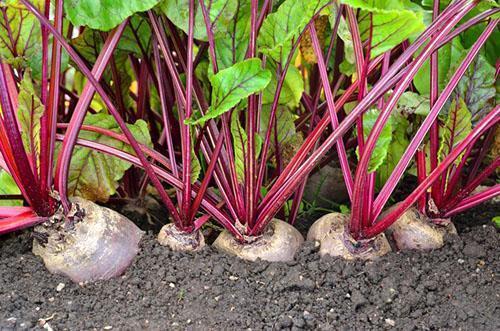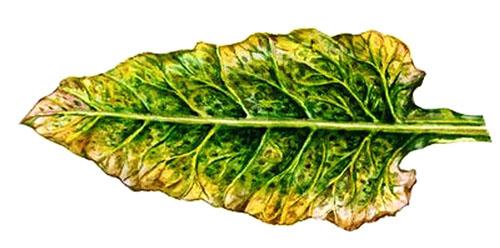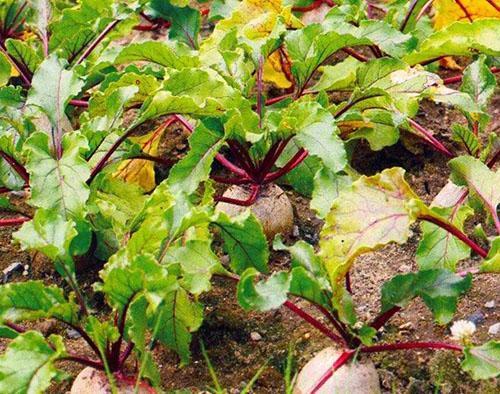Beet diseases: visual photos, detailed description and situational treatment
 Juicy and rich in trace elements, beets are a favorite habitat for many pathogens. You need to know the diseases of beets: their photos, descriptions and treatment are something that every gardener will definitely need. Because due to diseases, the yield of the root crop is significantly reduced. If you do not take any measures, then you can lose up to 70% of the crop.
Juicy and rich in trace elements, beets are a favorite habitat for many pathogens. You need to know the diseases of beets: their photos, descriptions and treatment are something that every gardener will definitely need. Because due to diseases, the yield of the root crop is significantly reduced. If you do not take any measures, then you can lose up to 70% of the crop.
To avoid losses, you need to know the first signs of disease. This will help to detect them in a timely manner and take appropriate measures. It is also necessary to have an understanding of the primary and secondary sources of infection.
Signs of downy mildew or beetroot downy mildew

Later, the infection will spread to the central rosette, buds in the periphery, flower-bearing shoots, perianths and seeds. Therefore, it is impossible to collect full-fledged seed material from such plants.
In one season, the mushroom can give several generations of spores. And the development of the disease is greatly facilitated by high humidity and cool temperatures. In order for the mushroom to germinate and begin to divide, it needs dripping moisture. Under suitable conditions, the maturation time for spores is reduced from 8 to 5 days.
 Sources of infection are:
Sources of infection are:
- Self-seeding plants that overwintered after harvest;
- Diseased root crops of this year: removed from the garden, but left within the site;
- Sick root crops of the last year, which remained in the ground, and this year have formed their own outlet;
- Infected seed.
Signs of beet ascochitis
 The lower, old leaves are first covered with blue-green spots, which later become necrotic brown sporulation foci. In the center of the brown spot there are many dark dots - this is the concentration of pathogens.
The lower, old leaves are first covered with blue-green spots, which later become necrotic brown sporulation foci. In the center of the brown spot there are many dark dots - this is the concentration of pathogens.
 Following the leaves, the fungus infects peduncles, seed plants and even root crops. During one vegetative period of beet, the mushroom can give several tens of generations. The damaged tops quickly die off, because of this, the development of the vegetable stops, and the yield of the plot falls by at least 15-17%.
Following the leaves, the fungus infects peduncles, seed plants and even root crops. During one vegetative period of beet, the mushroom can give several tens of generations. The damaged tops quickly die off, because of this, the development of the vegetable stops, and the yield of the plot falls by at least 15-17%.
And you can get rid of ascochitis and peronosporosis only with the help of fungicides. In addition, it is very important to maintain the correct fertilization system. It is necessary to form it taking into account the needs of the soil and the vegetable itself. Doses of top dressing should not only be balanced, but also justified by the urgent need for root crops.
Signs of cercosporosis: fungal pathogen and its treatment
 Beet cercosporosis is a leaf spot caused by a pathogenic fungus. Every year, this disease deprives many summer residents of their legal harvest, because it develops very quickly and aggressively.
Beet cercosporosis is a leaf spot caused by a pathogenic fungus. Every year, this disease deprives many summer residents of their legal harvest, because it develops very quickly and aggressively.
On the vegetable itself, this disease manifests itself under the guise of numerous round and oval spots that have a gray-brown tint. The spot has a characteristic brown necrotic border. The diameter of the fungal infection is up to 6 mm. Over time, the necrotic parts merge, and the entire leaf is affected. The dried tissue falls off.
If urgent measures are not taken, the pathogen fungus will very quickly move from the focal form of existence to the occupation of the entire plot. With such active reproduction, there is a high risk of death of all green tops.
Measures to combat beet cercosperosis are as follows:
- Preventive treatment of plots with beets with Rex Duo and Abacus preparations. The consumption rate for preventive measures is 0.7 liters per hectare.
- Urgent use of fungicides such as Abacus, Rex and Tango. Which are characterized by high antifungal effectiveness. And also have the longest period of protection, up to harvest. This method is most effective for early detection of infected plants;
- Collection and incineration of infected plants. All manipulations for the disposal of spore-bearing parts are best carried out outside of your site, which will help to avoid the spread of the fungus by air.
Redness of beet leaves and petioles: illness or lack of nutrition
 Why do beets have red leaves? This situation is often observed both at the time of growing seedlings and in open beds.
Why do beets have red leaves? This situation is often observed both at the time of growing seedlings and in open beds.
In the first case, a variety of factors can act as the root cause, for example, instead of river sand, sea sand was mixed into the soil mixture. With such a poisoning, the plants must be urgently transplanted, and their roots must be thoroughly rinsed with water.
Also, the leaves of the seedlings can turn red if additional fertilizing has been added to the already fertilized factory soil mixture. With an overabundance of trace elements, the tops of the seedlings first turn red, and then dry out and die off completely.
What to do if red leaves of beets have appeared already in the open field? The reasons that could cause redness, in this case, can be much more:
- Insufficient amount of applied phosphorus fertilizers. The solution to the problem is very simple: just add the necessary preparations to the soil.
- Increased acidity of the soil. Alkalization or oxidation of the soil prevents the beets from assimilating the necessary fertilizing and minerals. Therefore, the growth of the root crop is minimal, and its tops acquire a crimson-red hue. Solution: water the area with milk of lime, and thus "acidify" the soil.
- Sodium deficiency. Solution to the problem: with the next watering, you need to add table salt to the water, in the ratio: one tablespoon of sodium per 10 liters of water. After the earthen coma has dried, you can sprinkle the plot wood ash, which will help plants to stock up on the necessary minerals.
Question. Outwardly, the beets grow normally, but when you pull them out of the ground, you see a break in the outer shell of the beets at ground level. Where does it come from? Thickening, lack of something or overabundance, disease?
This is how beets (carrots) react to uneven watering. If there is hot dry weather for a long time, and then there are prolonged rains, then the harvest looks just like this.